Sacra Pagina New Testament Commentary Series | SP (18 vols.)
Overview
The expression “Sacra Pagina” (“Sacred Page”) originally referred to the text of Scripture. In the Middle Ages, it also described the study of Scripture to which the interpreter brought the tools of grammar, rhetoric, dialectic, and philosophy.
This series presents fresh translations and modern expositions of all the books of the New Testament. Written by an international team of Catholic biblical scholars, it is intended for biblical professionals, graduate students, theologians, clergy, and religious educators. The volumes present basic introductory information and close exposition, with each author adopting a specific methodology while maintaining a focus on the issues raised by the New Testament compositions themselves. The goal of Sacra Pagina is to provide sound, critical analysis without any loss of sensitivity to religious meaning. This series is therefore catholic in two senses of the word: inclusive in its methods and perspectives, and shaped by the context of the Catholic tradition.
The Second Vatican Council described the study of “the sacred page” as the “very soul of sacred theology” (Dei Verbum 24). The volumes in this series illustrate how Catholic scholars contribute to the council’s call to provide access to Sacred Scripture for all the Christian faithful. Rather than pretending to say the final word on any text, these volumes seek to open up the riches of the New Testament and to invite as many people as possible to study seriously the “sacred page.”
This series brings a unique depth of interaction with ancient and modern sources. In Verbum, you can investigate these references simply by hovering your mouse over them. Additionally, Sacra Pagina will appear in your Passage Guide or Sermon Starter Guide, allowing you to interact with the text any time you search by passage or topic. If you loved having these books in print, having them in Verbum will renew and refresh your love for this highly acclaimed New Testament commentary.
Sacra Pagina: First Corinthians and Sacra Pagina: Hebrews are Catholic Press Association Award Winners from 2000 and 2008, respectively.
Key Features
- High-quality contemporary commentary ideal for pastors and seminarians
- Written by internationally renowned and highly respected biblical scholars
- Complete, thorough commentary on the entire New Testament
Praise for the Print Edition
Represents the best of contemporary and pastorally sensitive biblical interpretation for a general readership. A must for any library.
—Catholic Library World
A good resource for preaching and teaching.
—Westcott House, from their list of recommended Bible commentaries
Reflect[s] the best of modern critical Catholic scholarship. The commentaries include fresh translation, critical analysis, and theologically sensitive exposition. . . . They vary more than many series in the depth of coverage they provide.
—D. A. Carson, from the New Testament Commentary Survey
Individual Titles
- Sacra Pagina: Gospel of Matthew by Daniel J. Harrington
- Sacra Pagina: Gospel of Mark by John R. Donahue and Daniel J. Harrington
- Sacra Pagina: Gospel of Luke by Luke Timothy Johnson
- Sacra Pagina: Gospel of John by Francis J. Moloney
- Sacra Pagina: Acts of the Apostles by Luke Timothy Johnson
- Sacra Pagina: Romans by Brendan Byrne
- Sacra Pagina: First Corinthians by Raymond F. Collins
- Sacra Pagina: Second Corinthians by Jan Lambrecht
- Sacra Pagina: Galatians by Frank J. Matera
- Sacra Pagina: Colossians & Ephesians by Margaret Y. MacDonald
- Sacra Pagina: Philippians & Philemon by Judith Ryan and Bonnie Bowman Thurston
- Sacra Pagina: First and Second Thessalonians by Earl J. Richard
- Sacra Pagina: The Pastoral Epistles by Benjamin Fiore
- Sacra Pagina: Hebrews by Alan C. Mitchell
- Sacra Pagina: James by Patrick J. Hartin
- Sacra Pagina: 1 Peter, Jude, 2 Peter by Donald P. Senior and Daniel J. Harrington
- Sacra Pagina: 1, 2, and 3 John by John Painter
- Sacra Pagina: Revelation by Wilfrid J. Harrington

Matthew wrote his Gospel from his perspective as a Jew. It is with sensitivity to this perspective that Harrington undertakes this commentary on the Gospel of Matthew.
After an introduction, he provides a literal translation of each section in Matthew’s Gospel and explains the textual problems, philological difficulties, and other matters in the notes. He then presents a literary analysis of each text (content, form, use of sources, structure). Bibliographies direct the reader to other important modern studies.
Daniel J. Harrington, SJ, PhD, is professor of New Testament at Weston School of Theology in Cambridge, Massachusetts, and general editor of New Testament Abstracts. He wrote The Gospel of Matthew and is the series editor of the Sacra Pagina series.
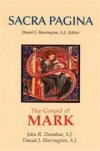
In The Gospel of Mark, Donahue and Harrington use an approach that can be expressed by two terms currently used in literary criticism: intratextuality and intertextuality. This intratextual and intertextual reading of Mark’s Gospel helps us to appreciate the literary character, its setting in life, and its distinctive approaches to the Old Testament, Jesus, and early Christian theology.
“Intratextuality” means we read Mark as Mark and by Mark. Such a reading expresses interest in the final form of the Gospel (not its source or literary history) and in its words and images, literary devices, literary forms, structures, characterization, and plot. Reading Mark by Mark gives particular attention to the distinctive vocabulary and themes that run throughout the Gospel and serve to hold it together as a unified literary production. “Intertextuality” comprises the relation between texts and a textual tradition, and also referring to contextual materials not usually classified as texts (e.g., archaeological data). “Intertextuality” is used to note the links of the text of Mark’s Gospel to other texts (especially the Old Testament) and to the life of the Markan community and of the Christian community today.
This commentary stands as a serviceable, detailed, and clearly written survey of Mark’s Gospel. . . . Readers in search of a solid, traditional take on Mark will find this book by two veteran scholars well-suited to their needs.
—Eric Thurman, Drew University
This commentary does a great deal in one volume and does it, on the whole, very well. I appreciate what the authors are attempting to pull together, and I would, without hesitation recommend it to students and use it in a class on Mark. . . . The intentional presence of literary-critical insights gives this work what no other commentary on Mark in a major commentary series now offers: an encouragement to students to pursue close readings of the biblical text that privilege the horizontal dimensions of the text over the vertical ones. For this we should be thankful for the risk the authors have taken in breaking new ground in this commentary on Mark.
—Erik M. Heen, The Lutheran Theological Seminary
John R. Donahue, SJ, PhD, is the Raymond E. Brown Distinguished Professor of New Testament Studies at St. Mary’s Seminary and University, Baltimore, Maryland. He is also the author of The Gospel in Parable: Metaphor, Narrative, and Theology in the Synoptic Gospels.
Daniel J. Harrington, SJ, PhD, is professor of New Testament at Weston School of Theology in Cambridge, Massachusetts, and general editor of New Testament Abstracts. He wrote The Gospel of Matthew and is the series editor of the Sacra Pagina series.
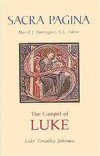
What makes this commentary on Luke stand apart from others is that, from beginning to end, this is a literary analysis. Because it focuses solely on the Gospel as it appears and not on its source or origin, this commentary richly and thoroughly explores just what Luke is saying and how he says it.
Luke Timothy Johnson is an American New Testament scholar and historian of early Christianity, and is the Robert W. Woodruff Professor of New Testament and Christian Origins at Candler School of Theology and a senior fellow at the Center for the Study of Law and Religion at Emory University. He is the author of Reading Romans: A Literary and Theological Commentary and Prophetic Jesus, Prophetic Church: The Challenge of Luke-Acts to Contemporary Christians.

No other book of the New Testament has attracted as much attention from commentators as the Fourth Gospel. It has stirred minds, hearts, and imaginations from Christianity’s earliest days. In The Gospel of John, Francis Moloney unfolds the identifiable “point of view” of this unique Gospel narrative and offers readers, heirs to its rich and widely varied interpretative traditions, relevance for their lives today.
The Gospel of John’s significance for Christianity has been obvious from the time of Irenaeus. It was also fundamental in the emergence of Christian theology, especially in the trinitarian and christological debates that produced the great ecumenical councils, from Nicaea to Chalcedon.
What sets this commentary on the Fourth Gospel apart from others is Moloney’s particular attention to the narrative design of the Gospel story. He traces the impact the Johannine form of the Jesus story has made on readers and explicates the way in which the author has told the story of Jesus. Through this he demonstrates how the Gospel story articulates a coherent theology, christology, and ecclesiology.
Francis J. Moloney (SDB, AM, BA, STD, LSS, PhD, FAHA) was born in Melbourne, Australia, educated by the Christian Brothers at St Bernard’s College, Moonee Ponds from 1953-57, and joined the Australian Province of the Salesians of Don Bosco in 1960.
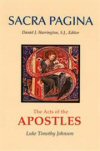
The Acts of the Apostles is the second volume in the two-part writing scholars call Luke-Acts. It continues the story begun in the Gospel of Luke, showing how the Good News offered by Jesus was eventually extended to the end of the earth, so that Gentiles as well as Jews came to share in the blessings of God.
This commentary treats Luke-Acts as an apologetic history. It takes with equal seriousness Luke’s literary artistry and his historical interests, fitting his methods comfortably within the ancient standards of historiography. This perspective illustrates in particular that Luke’s historical narrative serves a definite religious intent. Tracing that intent through the specific contours of Luke’s story is the special contribution of this commentary.
Luke Timothy Johnson is an American New Testament scholar and historian of early Christianity, and is the Robert W. Woodruff Professor of New Testament and Christian Origins at Candler School of Theology and a senior fellow at the Center for the Study of Law and Religion at Emory University. He is the author of Reading Romans: A Literary and Theological Commentary and Prophetic Jesus, Prophetic Church: The Challenge of Luke-Acts to Contemporary Christians.
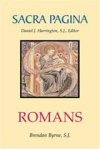
This commentary adopts a literary-rhetorical approach, viewing the letter as an instrument of persuasion designed to transform readers through a celebratory presentation of the Gospel. Reflecting upon the fate of Jews and Gentiles, Paul wins his audience to a vision of a God who always acts inclusively. The God who, in the person of Israel’s Messiah (Jesus), has acted faithfully to include the Gentile peoples within the community of salvation, will not fail to see to the eventual inclusion of Israel as well. In the victory of grace displayed already in the risen humanity of Jesus, the original design of the Creator for human communities and for the world begins to come true.
The interpretation of Paul’s letter to Rome has accompanied and stimulated the path of Christian theology down to today. Romans touches upon virtually all main issues of Christian theology, as well as presenting a rewarding introduction to Paul. Byrne facilitates full access to Paul and his Gospel through the letter, allowing Christians today to hear his voice as intelligibly and powerfully as it has spoken to past generations.
One can commend this commentary with confidence, not because one is persuaded by all its judgments (what commentary, especially on Romans, achieves that?), but because Byrne has struggled not only with Paul but also with the issues Paul struggled with. Alert users will appreciate that.
—Leander E. Keck, Yale Divinity School
Brendan Byrne, SJ, PhD, is professor of New Testament at Jesuit Theological College, Parkville, Victoria, Australia.
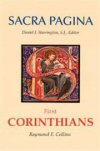
Sacra Pagina: First Corinthians is a 2000 Catholic Press Association Award Winner!
One of the most exciting of Paul’s letters, 1 Corinthians offers a vantage point from which modern readers can reflect on diverseness in Christian Churches today. In First Corinthians, Raymond Collins explores that vantage point as well as the challenge Paul posed to the people of his time—and continues to pose in ours—to allow the gospel message to engage them in their daily lives.
Paul introduces us to a flesh-and-blood community whose humanness was all too apparent. Sex, death, and money were among the issues they had to face. Social conflicts and tension within their Christian community were part of their daily lives. Paul uses all of his diplomacy, rhetorical skill, and authority to exhort the Corinthian community to be as one in Christ.
In examining Paul’s message and method, Collins approaches 1 Corinthians as a Hellenistic letter written to people dealing with real issues in the Hellenistic world. He cites existing Hellenistic letters to show that Paul was truly a letter writer of his own times. Collins makes frequent references to the writings of the philosophic moralists to help clarify the way in which Paul spoke to his beloved Corinthians. He also comments on some aspects of the social circumstances in which the Christians of Corinth actually lived.
The distinctive feature of this commentary lies in Collins’ efforts to place 1 Corinthians within its cultural context. The author makes extensive reference to epistolary customs, rhetorical practices, and philosophical discussions of the ancient Greco-Roman world that parallel what is found in 1 Corinthians. . . . Collins consistently provides lucid, concise summaries of the pericope’s place within the context of the letter, of its internal structure, and of its key themes. Consequently, the reader can quickly gain an accurate orientation to any individual passage within the letter. This volume, therefore, will reward the interpreter who consults it as his or her first secondary source.
—James C. Miller, Daystar University, Nairobi, Kenya
Raymond Collins, PhD, is a priest of the Diocese of Providence and is the dean of the School of Religious Studies at The Catholic University of America. He is the author of John and His Witness and Divorce in the New Testament.
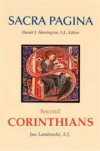
Regarded as the most personal of Paul’s “weighty and strong” (2 Cor. 10:10) letters, the Second Letter to the Corinthians continues to contribute toward the ”building up” (13:10) of its readers.
The Second Letter to the Corinthians is an implicit yet undeniable plea that Paul addresses to the Christians of Corinth and is impressive above all for its exposition of the apostle’s identity. In this letter Paul more than once fiercely counters the attacks of his opponents. He extensively describes both the quality and circumstances of his apostolic existence: the sufferings he endures, the opposition he encounters, and his continual care for the Churches. Second Corinthians is, therefore, highly significant theologically as well as autobiographically.
Not an easy letter to follow, the emotional language used in Second Corinthians, the question of the integrity of Second Corinthians as a letter, and inadequate information about the concrete situation at Corinth and the identity of Paul’s opponents make following the flow of Paul’s argument difficult at times. Yet Second Corinthians is an especially important document because of Paul’s ongoing reflection on his ministry. It is both profound in its content and style for its original audience as well as for today’s readers.
Jan Lambrecht, in his new commentary, stands apart from the majority. He rejects the various division hypotheses and aligns himself with the very few individuals who see in 2 Corinthians a single, unified letter. . . . In sum, . . . it is quite good when looking at the text verse by verse and section by section. . . . The [‘Interpretation’ sections] are clear and to the point, and carefully guide the reader through the complex argumentation of the different sections of the letter. This makes this a solid resource for undergraduate students or the general public. The fact that the whole book is concise also will appeal to these people. On the other hand, the more detailed ‘Notes’ sections are beyond the reach of the typical undergraduate or anyone who is not well-grounded in the Greek New Testament. These sections of the commentary will appeal more to seminarians, graduate students, and scholars.
—Paul B. Duff, George Washington University
Jan Lambrecht, SJ, is professor emeritus of New Testament and biblical Greek at the Catholic University of Leuven, Belgium.

Paul’s Letter to the Galatians has played a major role in the history of theology, especially in the Church’s teaching on grace, faith, and justification. This commentary argues that Paul’s doctrine of justification by faith is essentially social in nature and has important ecumenical implications for the Church today. In its original setting, Galatians established a foundation for the unity of Jewish and Gentile Christians: all are justified by the faith of Jesus Christ.
In addition to illuminating the historical situation that led Paul to write his Letter to the Galatians, this commentary pays careful attention to the rhetorical structure of this letter and its theological message. The author provides a fresh translation of Galatians, critical notes on each verse of the text, and a careful commentary of the letter in light of Paul’s theology.
Theories abound on the question of Galatians, why it was written, what it says, and what the implications of that message are. Yet few scholars have devoted themselves at length to this letter. What sets this work apart is its extent and detail, and its academic rather than popular intent.
Frank J. Matera is currently the Andrews-Kelly-Ryan Professor of Biblical Studies and a professor of New Testament at the Catholic University of America. He studied at Thomas Seminary in Bloomfield, St. Bernard Seminary in Rochester, and at the Catholic University of Louvain, where he received his MA. After several years of parish work, he pursued doctoral studies at Union Theological Seminary in Richmond, VA, where he received his PhD in 1981. His dissertation, “The Kingship of Jesus: Composition and Theology in Mark 15,” was subsequently published by Scholars Press. Professor Matera taught at St. John’s Seminary in Boston from 1982 to 1987 and has taught at the Catholic University of America since 1988, and is also a priest of the Archdiocese of Hartford.
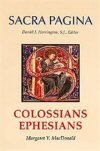
No two works in the Pauline Epistles resemble each other as closely as Colossians and Ephesians. Often recognized for their majestic tone and powerful theological statement, Colossians and Ephesians also present many challenges of interpretation. Most commentaries on these letters seem preoccupied with the same few issues, particularly the question of authorship. As MacDonald addresses these classic questions, she offers a fresh perspective on Colossians and Ephesians by making use of insights from the social sciences. Moreover, by paying attention to subtle differences between the two letters, she brings their distinct perspectives into sharp relief.
MacDonald highlights the interplay between Colossians and Ephesians and the social life of New Testament communities. She illustrates how the texts reflect ancient cultural values and are influenced by particular aspects of community life such as worship and household existence. In particular, she reflects on the issues faced by these communities as they formed institutions and interacted with the society around them. She shows the struggles of the New Testament communities to survive and maintain a distinct identity in first-century society.
This commentary brings together insights from ritual studies, anthropology, gender analysis, and different branches of sociology in a way that no other commentary on these letters does. This book will be an essential tool for the interpreter of Colossians and Ephesians and would serve well as a textbook for seminary courses on those letters.
—Richard B. Vinson, Baptist Theological Seminary at Richmond
Margaret Y. MacDonald is a professor in the department of religious studies at St. Francis Xavier University in Nova Scotia.

Although relatively brief, Philippians is one of the most interesting and beloved of Paul’s undisputed epistles. In Philippians and Philemon, Bonnie Thurston makes a convincing case that canonical Philippians is as Paul wrote it, one letter. Although there is not enough specific evidence to “name names,” she suggests a number of possible audiences. A translation conforming as closely as possible to the original Greek is provided, along with a careful analysis of the language of the letter that yields insights into the context and theological underpinning of this epistle.
The apostle’s very brief letter to Philemon stands solidly within the Pauline collection of authentic and canonical letters. In this volume, Judith Ryan argues that Philemon makes two specific appeals. The first seeks to elicit Philemon’s partnership and his community’s support in welcoming Onesimus back as both beloved brother and honored guest. The second requests that Onesimus be allowed to use the freedom he already has to serve Christ and his Gospel. In this commentary Ryan provides a fresh translation, critical notes for each verse, and interpretation on defined sections. She situates the letter in the historical context of slavery in the ancient world and shows how Paul combined his theology with contemporary rhetorical strategies to produce an effective challenge to his audience.
Volume 10 in the Sacra Pagina commentary series is easy to read; both of its authors write in a clear and lucid style, present different opinions on hotly debated issues in the scholarship on the letters of Philippians and Philemon accompanied by references to the positions of others, and offer well-balanced notes and remarks on the texts of two important Pauline letters. This volume is a valuable introduction to and commentary on Philippians and Philemon, although its depth in scholarship is somewhat restricted and could imply that its primary appeal will not be found among professional biblical scholars. However, the breadth of the positions and insights offered will likely ensure its value for its envisaged readership in the professional ministry and other interested parties in the church—and in this regard the commentary is strongly recommended.
—Jeremy Punt, Stellenbosch University
Bonnie B. Thurston, PhD, lives in West Virginia in solitude. She is ordained in the Christian Church (Disciples of Christ) and the author of several books, including The Spiritual Landscape of Mark, Religious Vows, the Sermon on the Mount, and Christian Living, and Preaching Mark.
Judith M. Ryan, PhD, STL, is associate professor of New Testament at the University of St. Thomas School of Theology at St. Mary’s Seminary, Houston, Texas. Previously she taught at Catholic University of America, Fordham University, the University of Scranton, College Misericordia, and St. Mary’s Seminary and University, Baltimore, Maryland.
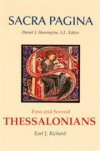
The letters First and Second Thessalonians are traditionally associated with the Pauline foundation of the Macedonian Church at Thessalonica. The first is seen as representing Paul’s earliest epistolary efforts and as providing two successive moments in his long relationship as advisor to that community. Soon after leaving the area for the southern province of Achaia, Paul addresses the concerns of the new Gentile converts and at a later period responds more directly to queries received from the thriving and successful community. The second document, written in Paul’s name and at a later date, attempts to calm the apocalyptic fervor of the community by reiterating its traditional eschatological and Christological teaching.
After treating these introductory matters, this study provides a new translation of each section of the canonical text, explains in notes the pertinent textual and linguistic features of the text, and then offers in a series of interpretive messages a literary, rhetorical, and thematic analysis of the biblical documents. The constant concern of this commentary is to provide assistance to modern readers in discerning the relationship between the authors and their intended readers. Short bibliographies suggest other important modern studies. Includes an updated bibliography as an appendix.
The strength of this commentary lies in its careful philological analysis of the text that helpfully illumines the key issues and central claims of the letters. Richard is clearly familiar with all the problems that the text presents and the various solutions that have been forwarded. . . . Richard has fulfilled the need for an up-to-date, detailed analysis of the Thessalonian letters that helpfully surveys and evaluates the key issues of the text.
—Jeffrey A. D. Weima, Calvin Theological Seminary
Earl J. Richard is professor emeritus of New Testament at Loyola University in New Orleans. He holds graduate degrees in biblical studies from Ottawa University, Johns Hopkins, and The Catholic University of America in Washington DC. He is the author of Jesus: One and Many and is editor and contributor to New Views on Luke and Acts. He is past president of the Society of Biblical Literature (southeast region) and a member of the Catholic Biblical Association.
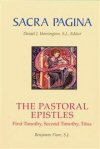
First and Second Timothy and Titus have, for many years, borne the collective title The Pastoral Epistles. Both their style and their content make it difficult to locate them within the corpus of Pauline letters, and recent scholarship most often considers them pseudonymous, works that imitate Paul’s letters but apply the apostle’s teaching to the concerns of a later time, two or more decades after Paul’s death.
The Pastorals differ from Paul’s own letters in being addressed to single individuals, coworkers of Paul who have been placed in charge of particular churches—Timothy apparently in Ephesus, Titus in Crete. They provide instruction for community leaders, both the individual addressees and other leaders whom they will appoint. The specification of certain offices within the local churches is one of the features that appear to locate these works in a later phase of church development.
In this commentary, Benjamin Fiore places the Pastorals in their historical and literary context. The reader will find here a solid introduction to parallel literary forms in Latin and Greek literature and particular descriptions of the way in which these documents use ancient rhetorical forms to achieve their paraenetic and hortatory purpose. Drawing on his parish experience as well as his academic training, Fiore also provides reflections on the contemporary pastoral application of these books, giving readers a renewed appreciation for the pastoral label these epistles bear.
Fiore’s commentary is an important contribution to the discussion of the Pastoral Epistles, an excellent introduction for those who wish to become acquainted with these epistles. The volume makes the reader aware of the manifold issues connected to the formation of tradition and the shaping of ministries and structures in the early church, as well as of the debates that preoccupied and divided Christians at the beginning of their history.
—Korinna Zamfir, Babes-Bolyai University, Romania
Fiore’s classical training under the supervision of Abraham Malherbe of Yale is put to valuable use throughout the commentary. By personal count, Fiore references over eighty Greco-Roman authors representing over 160 works. What is more remarkable is the fact that Fiore manages to use these references judiciously, rather than devolving into parallelomania.
—Matthew D. Montonini, MA, Ashland Theological Seminary
Benjamin Fiore, SJ, is president and professor of religious studies at Campion College at the University of Regina.

Sacra Pagina: Hebrews was a 2008 Catholic Press Association Award Winner!
Scarcely any book of the New Testament (with the possible exception of Revelation) is so perplexing as the Letter to the Hebrews. Not really a letter, but a sermon with some features of a letter added to it, not really by its putative author, Paul, but by an anonymous Christian who wrote some of the most elegant Greek in the Bible, not really addressed to the Hebrews, but to Christians, probably in Rome—this is the work that Alan Mitchell explains in this commentary.
Many scholars have written fine commentaries on Hebrews, and Mitchell stands on their shoulders, noting where he proposes alternate interpretations. Mitchell pays particular attention to the reliance of the author of Hebrews on the Greek Old Testament (the Septuagint). He also compares the language of Hebrews with similar usage and ideas of first-century Hellenistic Jewish authors, notably Flavius Josephus and Philo of Alexandria. Furthermore, he situates Hebrews against the background of the tradition of Hellenistic Moral Philosophy, where that is appropriate. Mitchell thus locates Hebrews in its proper thought-world, something that is essential for the modern reader in dealing with some of the thornier questions raised by this biblical book. Chief among these are the role of sacrificial atonement, the question of second repentance, and the spiritual and moral formation of the Roman Christians who were its recipients.
Like all the volumes in the Sacra Pagina series, this work examines the text in detail, with careful attention to the words and phrasing, and then brings those individual insights together into a coherent summary. The bibliography and special lists appended to each chapter cover the best of recent scholarship on the Letter to the Hebrews.
Alan C. Mitchell, PhD, is associate professor of New Testament Studies and Christian Origins at Georgetown University and is director of the Annual Georgetown University Institute on Sacred Scripture. He is a member of the Society of Biblical Literature and Catholic Biblical Association.

In his commentary on the letter of James, Hartin offers a unique approach toward understanding a much-neglected writing. Refusing to read the letter of James through the lens of Paul, Hartin approaches the letter in its own right. He takes seriously the address to “the twelve tribes in the Dispersion” (James 1:1) as directed to Jews who had embraced the message of Jesus and were living outside their homeland, Israel. At the same time, Hartin shows how this letter remains true to Jesus’ heritage. Using recent studies on rhetorical culture, Hartin illustrates how James takes Jesus’ sayings and performs them again in his own way to speak to the hearers/readers of his own world.
Hartin examines the text, passage by passage, while providing essential notes and an extensive explanation of the theological meaning of each passage. The value of this commentary lies in its breadth of scholarship and its empathic approach to this writing. The reader will discover new and refreshing insights into the world of early Christianity as well as a teaching that is of perennial significance.
Patrick J. Hartin was born and raised in Johannesburg, South Africa. He studied at the Gregorian University in Rome and is an ordained priest of the Diocese of Spokane, Washington. He holds two doctorates in theology: in ethics and in the New Testament, both from the University of South Africa. Presently he teaches courses in the New Testament and in classical civilizations at Gonzaga University. He is the author of 11 books, including: Apollos (Paul’s Social Network series), James of Jerusalem (Interfaces series), and James, First Peter, Jude, Second Peter (New Collegeville Bible Commentary series).

Crisis in the church is not a new phenomenon. In fact, the church has always been—and probably always will be—involved in some kind of crisis. Even in the apostolic period, which is regarded by many as the church’s golden age, there were serious crises coming both from the outside, as in 1 Peter, and from the inside, as in Jude and 2 Peter. The three short New Testament letters treated in 1 Peter, Jude, and 2 Peter illustrate the problems early Christians faced, as well as the rhetorical techniques and theological concepts with which they combated those problems.
In the first part of this volume, Donald Senior views 1 Peter as written from Rome in Peter’s name to several churches in northern Asia Minor—present-day Turkey—in the latter part of the first century CE. The new Christians addressed in 1 Peter found themselves aliens and exiles in the wider Greco-Roman society and suffered a kind of social ostracism. But they are given a marvelous theological vision of who they have become through their baptism and pastoral encouragement to stand firm. They are shown how to take a missionary stance toward the outside world by giving the witness of a holy and blameless life to offset the slander and ignorance of the non-Christian majority and possibly even to lead them to glorify God on the day of judgment.
In the second part of this volume, Daniel Harrington interprets Jude and 2 Peter as confronting crises in the late first century that were perpetrated by Christian teachers who are described polemically as intruders in Jude and as false teachers in 2 Peter. In confronting the crises within their churches, the authors appeal frequently to the Old Testament and to early summaries of Christian faith. While Jude uses other Jewish traditions, 2 Peter includes most of the text of Jude as well as many distinctively Greek terms and concepts. It is clear that for the authors, despite their different social settings, what was at stake was the struggle for the faith.
Daniel J. Harrington, SJ, is a professor of New Testament at Weston Jesuit School of Theology in Cambridge, Massachusetts, and general editor of New Testament Abstracts. He is a past-president of the Catholic Biblical Association of American and the series editor of the Sacra Pagina series. He also wrote The Gospel of Matthew in the Sacra Pagina series.
Donald Senior, CP, is a professor of New Testament studies and president of Catholic Theological Union in Chicago. He was recently appointed by Pope John Paul II to the Pontifical Biblical Commission. General editor of The Bible Today, he also co-edited The Collegeville Pastoral Dictionary of the Bible and the 22-volume international commentary series New Testament Message, and he wrote the four-volume The Passion series published by The Liturgical Press.
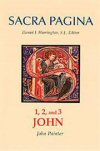
Sacra Pagina: 1, 2, and 3 John
- Author: John Painter
- Publisher: Liturgical Press
- Publication Date: 2008
- Pages: 411
The Johannine Epistles are today read as an important part of the Johannine literature. Yet the meaning of the text is often unclear. Part of the problem arises because, although 1 John is called an epistle, it lacks the formal marks of an epistle. In 1, 2, and 3 John, John Painter illuminates the relationship 1, 2, and 3 John have to each other and to the Gospel.
Painter explains the historical context of the Johannine Epistles using a socio-rhetorical approach. The writings are shown to reflect a situation of conflict and schism within the Johannine community; they seek to persuade the readers of the truth of the writer's message. In this truth, the readers are encouraged to abide if they would have the assurance of eternal life.
Painter also examines the inseparable connection between belief and ethical life in active love for one another. Through the socio-rhetorical approach Painter brings to light the continuing relevance of these writings.
John Painter is the Foundation Professor of Theology at Charles Sturt University in Canberra, Australia.
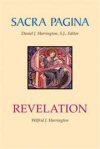
Sacra Pagina: Revelation
- Author: Wilfrid J. Harrington
- Publisher: Liturgical Press
- Publication Date: 2008
- Pages: 296
More than any other New Testament writing, the Book of Revelation demands commentary. Its often-bewildering text is easily open to less-than-scholarly interpretation.
Wilfrid Harrington brings his scholarship to the Book of Revelation and conveys its Christian message. He puts the work in its historical and social setting—a first-century CE province of the Roman Empire—and explores its social and religious background and its literary character. Through Harrington we hear clearly the challenge of John, the prophet, to the churches of his time—and to ours—not to compromise the Gospel message.
Wilfrid John Harrington is an Irish Dominican priest. He studied theology in Rome and biblical studies in Jerusalem, and currently teaches Scriptures at the Priory Institute, at the Church of Ireland Theological College, and at Milltown Institute of Theology and Philosophy, all of which are in Dublin.
Product Details
- Title: Sacra Pagina New Testament Commentary Series
- Series Editor: Daniel J. Harrington
- Series: Sacra Pagina New Testament Commentary Series
- Publisher: Liturgical Press
- Volumes: 18
- Pages: 7,600
About the Series Editor
Daniel J. Harrington, SJ, PhD, is professor of New Testament at Weston School of Theology in Cambridge, Massachusetts, and general editor of New Testament Abstracts. He wrote The Gospel of Matthew and is the series editor of the Sacra Pagina series.
Sacra Pagina: First Corinthians and Sacra Pagina: Hebrews are Catholic Press Association Award Winners from 2000 and 2008, respectively.

- High-quality contemporary commentary ideal for pastors and seminarians
- Written by internationally renowned and highly respected biblical scholars
- Complete, thorough commentary on the entire New Testament
Represents the best of contemporary and pastorally sensitive biblical interpretation for a general readership. A must for any library.
—Catholic Library World
A good resource for preaching and teaching.
—Westcott House, from their list of recommended Bible commentaries
Reflect[s] the best of modern critical Catholic scholarship. The commentaries include fresh translation, critical analysis, and theologically sensitive exposition. . . . They vary more than many series in the depth of coverage they provide.
—D. A. Carson, from the New Testament Commentary Survey
- Title: Sacra Pagina New Testament Commentary Series
- Series Editor: Daniel J. Harrington
- Series: Sacra Pagina New Testament Commentary Series
- Publisher: Liturgical Press
- Volumes: 18
- Pages: 7,600
Daniel J. Harrington, SJ, PhD, is professor of New Testament at Weston School of Theology in Cambridge, Massachusetts, and general editor of New Testament Abstracts. He wrote The Gospel of Matthew and is the series editor of the Sacra Pagina series.
Reviews
16 ratings

Deacon Kurt Lucas
1/25/2019

Deacon Kurt Lucas
1/25/2019
Jonathan Mordosky
4/24/2018

Rev. Dr. K. Robert Schmitt
4/8/2018
Easterling
1/17/2018
Leonardo Buscemi
2/23/2017

Anthony Sims
7/29/2015

Larry Proffitt
5/1/2015

Mark Nolette
2/3/2014